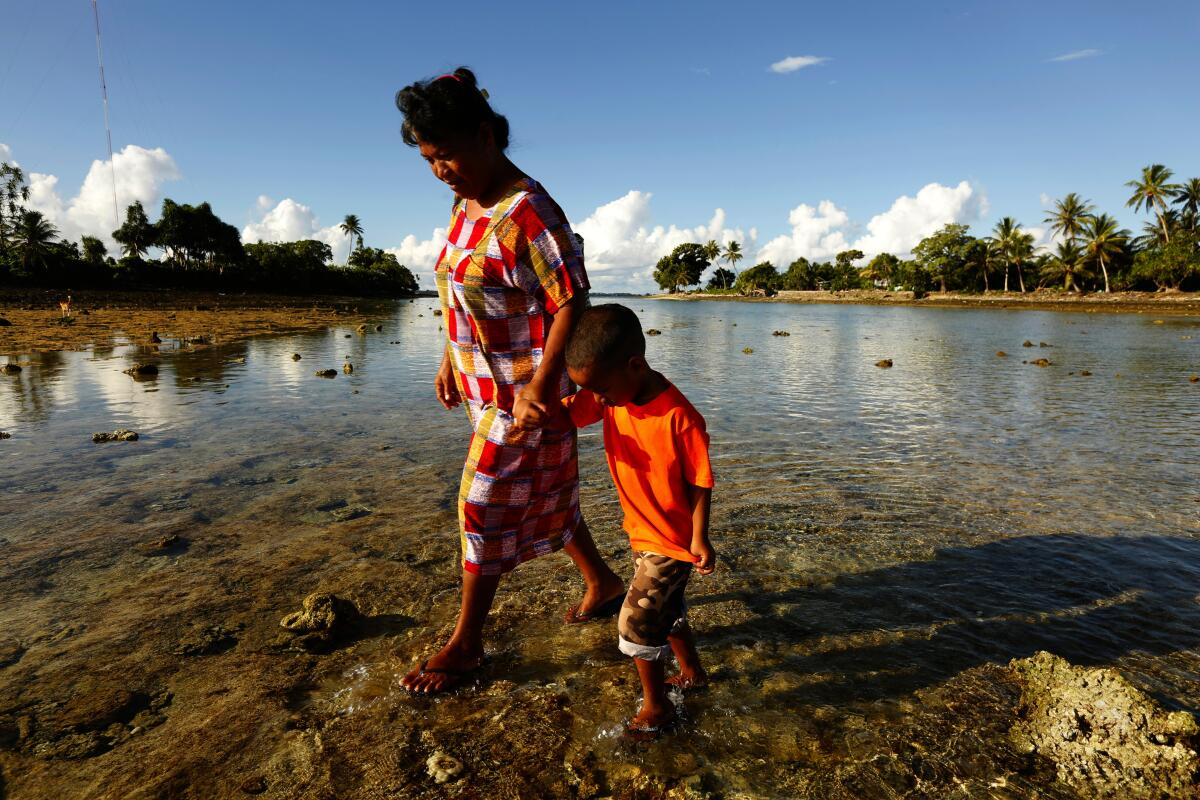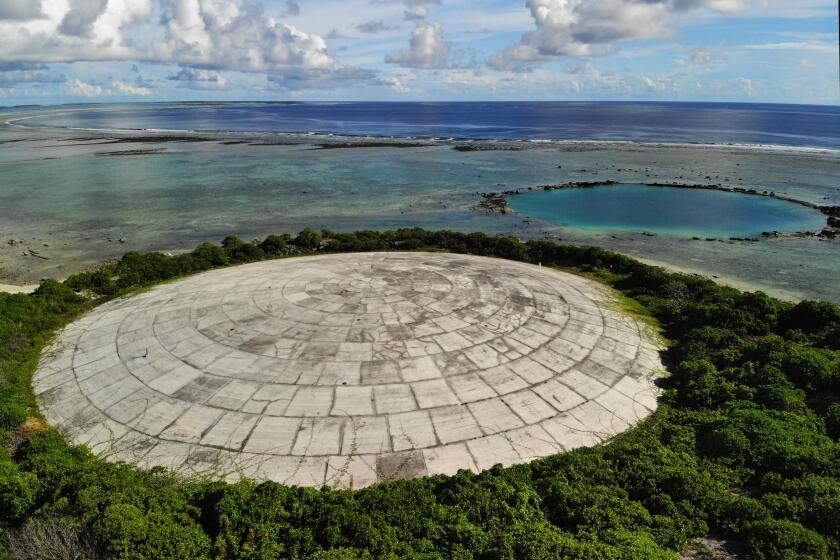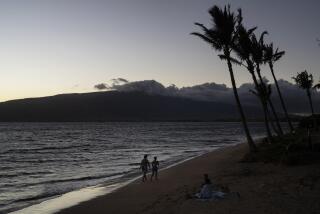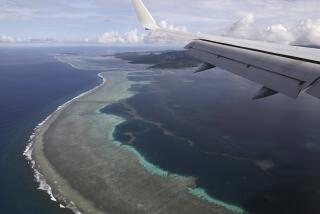As COVID-19 cases climb in the U.S., there are still none in the Marshall Islands

- Share via
As coronavirus cases climb in California and many U.S. states, some Pacific Island nations have safely ridden out the storm.
The Marshall Islands is still COVID-19 free.
“We saw the threat and took action early,” said Jack Niedenthal, secretary of Health for the mid-Pacific island nation, describing the island nation’s March 3 travel ban, which prevented incoming travelers from across the globe. The Marshallese government had banned travelers from China several weeks earlier.
The safe status of the Marshall Islands contrasts with what Marshallese immigrants are experiencing in the United States. As The Times recently reported, Marshallese have been disproportionately infected with the coronavirus in cities such as Spokane, Wash., and Springdale, Ark., in part because many of them serve as essential workers.
In the South Pacific and Central Pacific, many islands nations, including New Zealand, have so far staved off the worst of COVID-19 by closing their borders early and taking other public health measures.
Across the globe, only six countries are reportedly COVID-19 free. With the exception of North Korea, all of them — Kiribati, Palau, American Samoa, Nauru and Micronesia — are Pacific Island nations that closed their borders to outside travelers.
As of Wednesday, there are nearly 3.5 million coronavirus cases in the United States, more than any other country.
The Marshall Islands’ travel ban is still in place — and currently extended through Aug. 5 — while the government builds the infrastructure and stockpiles the equipment it will need should the virus invade.
According to Casten Nemra, the Marshall Islands’ minister for Foreign Affairs and Trade, construction on a new COVID-19 medical isolation center on Majuro — the nation’s capital and most populated island — is almost complete.
“Then we can begin bringing back our citizens who have been stranded,” he said, noting the nearly 500 Marshallese traveling abroad when the travel ban was announced — including Niedenthal’s wife, daughter and grandson, who were visiting family in Portland.
When the pandemic spread out of China and Europe earlier this year, the Marshall Islands had already been restricting domestic travel because of a dengue fever outbreak. So the decision to close down early was easy.
“People thought we were out of our minds,” said Niedenthal, who leads the nation’s healthcare response. “They said travel bans don’t work.”
But for island nations, he said, they do.
Now the nation is considering restricting outbound travel too.
Niedenthal said the Marshallese are watching “the mass chaos in the U.S.” where government officials “have lost control over the disease and don’t seem to be doing anything on the federal level to protect its own citizens.”
“Given how hard our own citizens have been hammered by this disease in the U.S., it just scares the hell out of us,” he said, noting that a decision is likely to be made by July 23, when the next commercial airline flight is scheduled to depart.
COVID-19 is disproportionately killing Marshallese immigrants in states such as Arkansas, Washington and Oregon, even as their homeland remains free of the coronavirus.
The United Airlines “island hopper” is the one commercial airline that flies to the Marshall Islands.
Before the pandemic, it made several inbound and outbound flights per week, as it transported people and cargo between Honolulu and Guam, making stops in the Marshall Islands’ Majuro and Kwajalein, as well as Micronesia’s Kosrae, Chuuk and Pohnpei.
Now it is making roughly one inbound and one outbound stop per month, said Jonathan Guerin, a United Airlines spokesman.
Although passengers are not allowed to de-board, cargo is off-loaded by a ground crew wearing protective gear. The airline crew and ground crew are never in contact. And the cargo is disinfected and quarantined, said Nemra.
The island nation is also restricting seaports, where the bulk of the nation’s commodities are imported.
While scores of large fishing and cargo vessels are generally anchored throughout Majuro’s lagoon, Nemra said the atoll now seems nearly empty.
Fishing vessels are required to spend 14 days on the water from their last port of departure before arriving in the Marshall Islands. Cargo ships bringing essentials, such as food and medical supplies, are exempted from the quarantine. However, they must provide health data on crew members for the 21-day period before arrival.
In addition, according to Nemra and Niedenthal, the cargo crew stays below deck and does not interact with the Marshall Islands-based ground crew while unloading.
In recent years, the Marshallese government has been recognized for its leadership on climate change, and now its COVID-19 response is getting international attention.
“It’s probably the safest place in the world to be right now,” said U.S. Ambassador Roxane Cabral, who was appointed in December and hasn’t left the Marshalls since.
But the restrictions haven’t come without a cost. According to the U.S. Department of Interior, the Marshall Islands is projected to incur a 6.9% decline in GDP and a loss of 716 jobs.
The United States is providing aid, said Cabral, noting roughly $850,000 earmarked in the CARES act, as well as funding from other U.S. agencies.
She said roughly $130 million in total has gone to the Compact of Free Association nations, which includes the Marshall Islands, Micronesia and Palau.
Cabral and the U.S. military are now working with the Marshallese to bring contractors from the United States to work on Kwajalein, where the military has a base.
Kwajalein “is like a small town,” said Cabral, describing the island’s workforce of firefighters, port workers, nurses, medics and engineers.
“The staff started to rotate out around the holidays,” she said, “and they couldn’t come back to fill key roles. It’s starting to put the remaining people on the base in serious risk.”
Acknowledging the U.S. situation, the Marshallese government worked with U.S. authorities on a protocol requiring personnel to be tested during a 72-hour period before they depart from Honolulu.
Upon arriving in Kwajalein, she or he must remain in quarantine for 21 days and be tested three more times before being released.
As of last week, 37 people had been allowed to return to Kwajalein.
More to Read
Sign up for Essential California
The most important California stories and recommendations in your inbox every morning.
You may occasionally receive promotional content from the Los Angeles Times.












